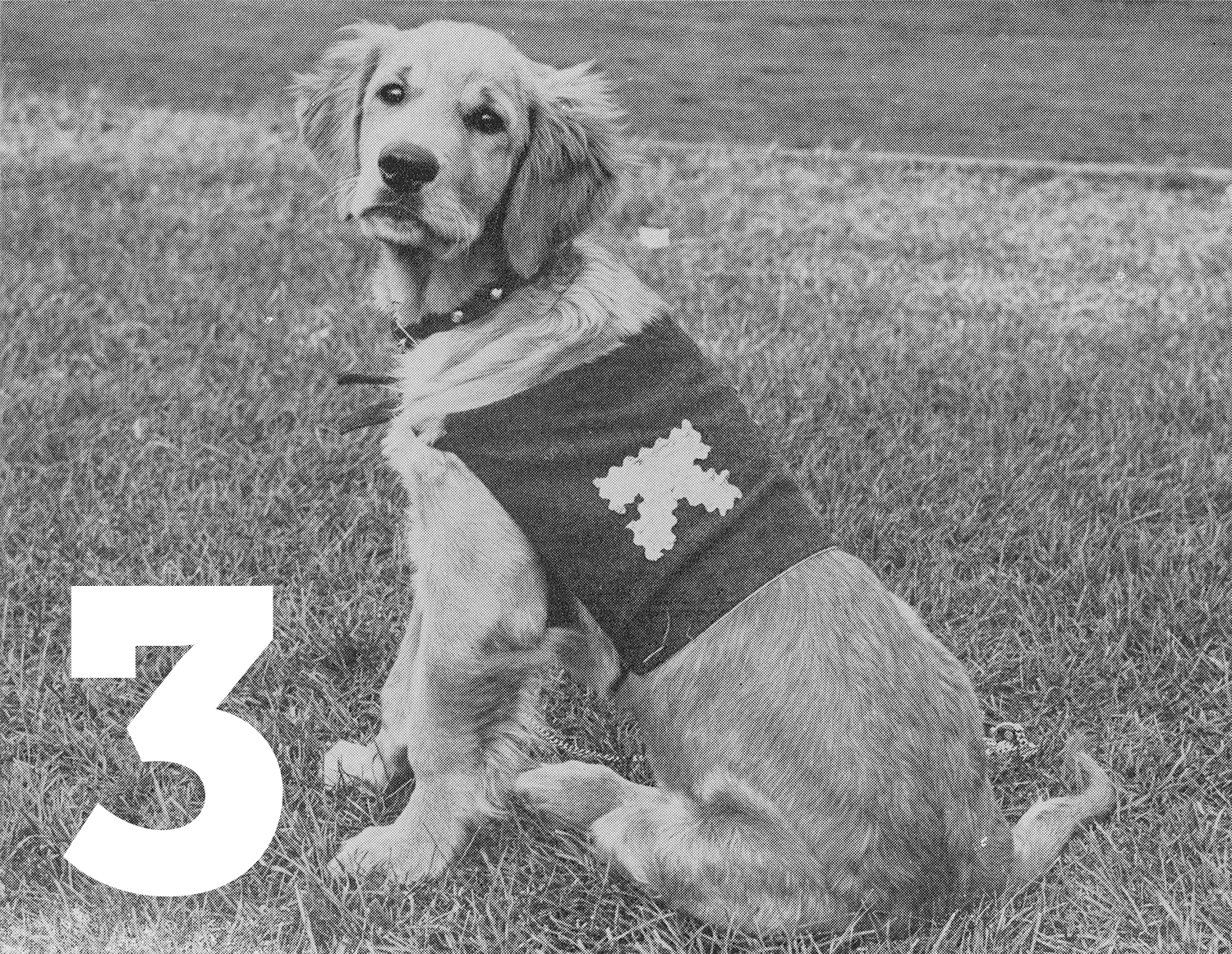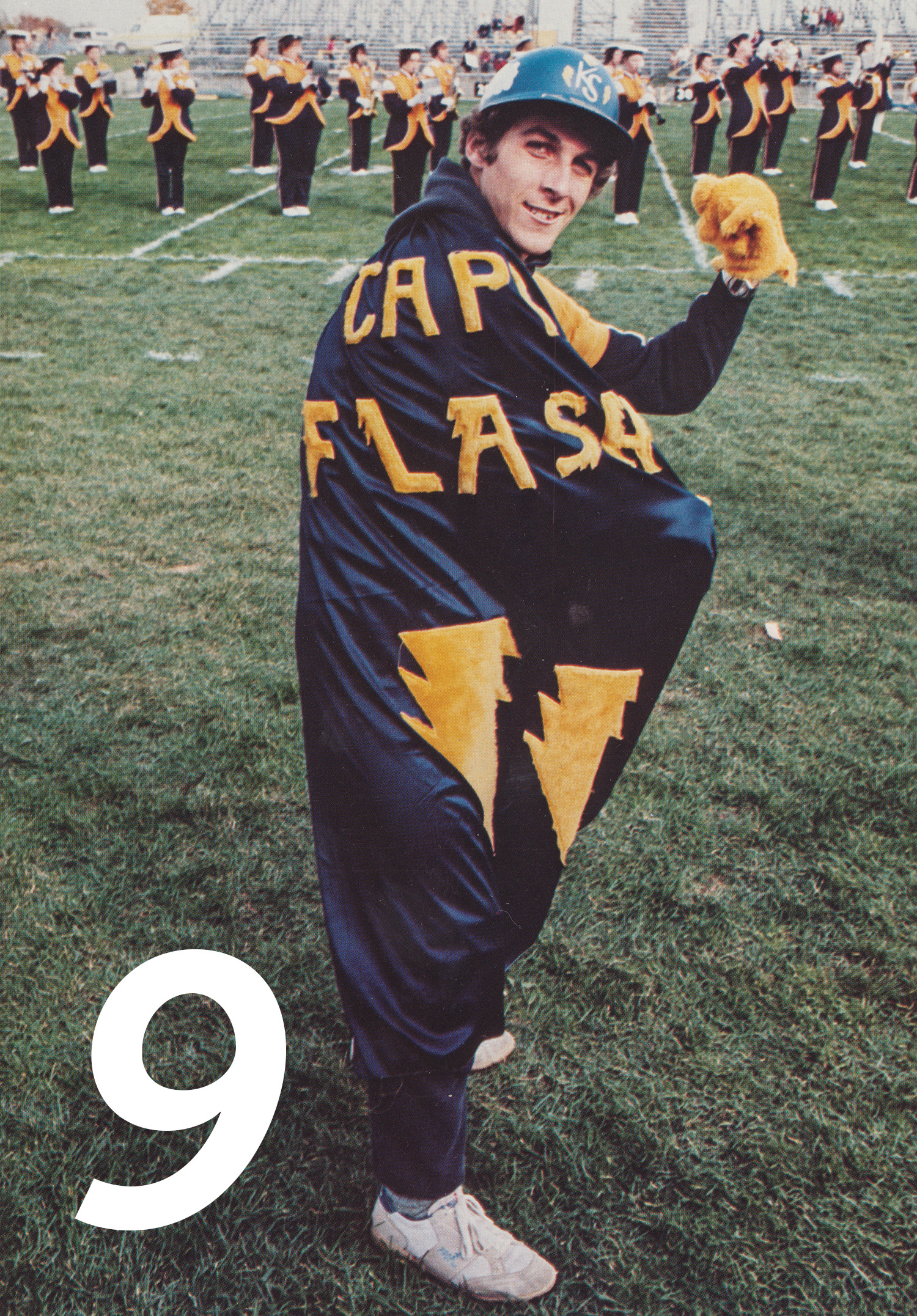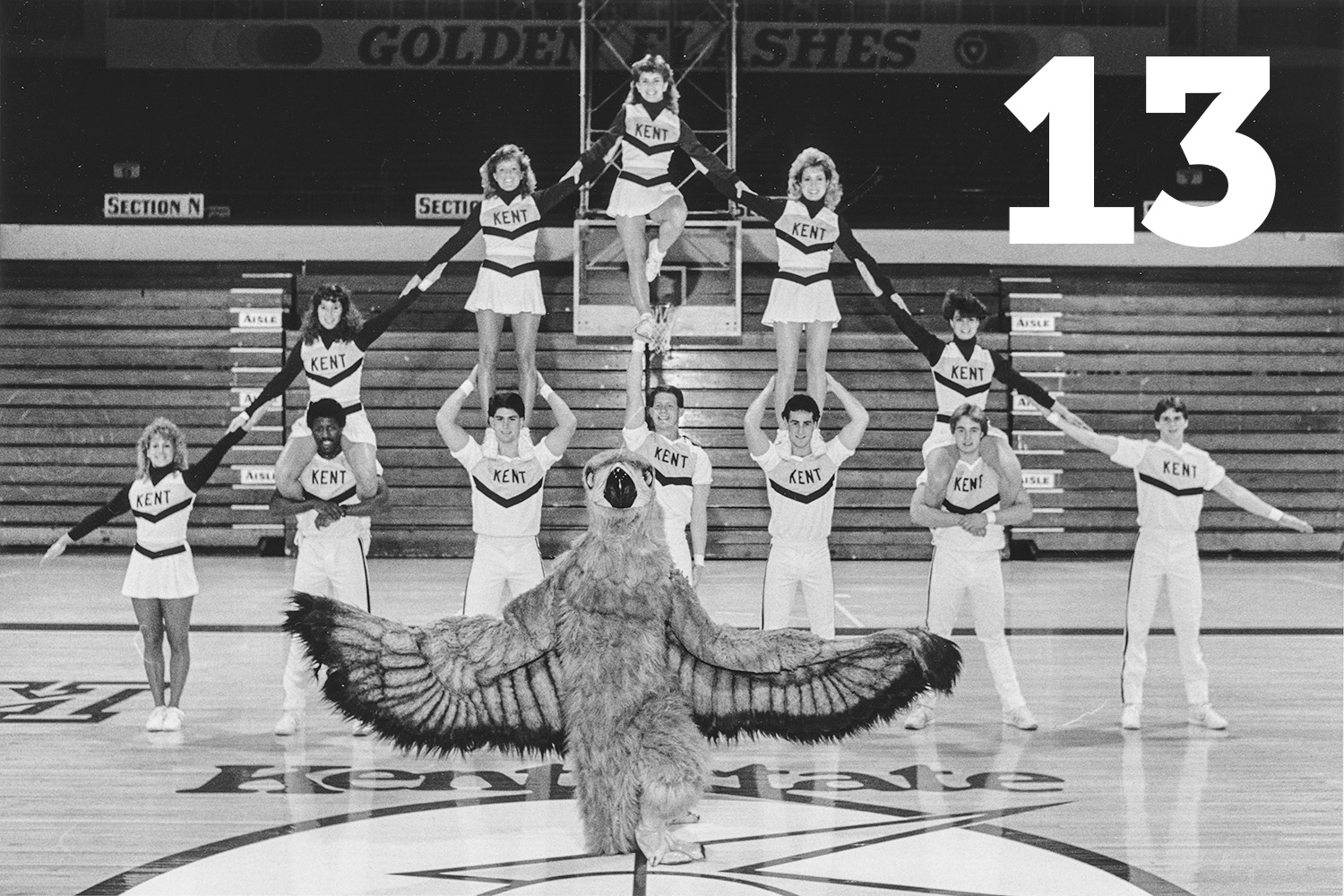The convoluted (and sometimes controversial) chronology of Ńż¼§Ö±²„ Stateās mascot
Compiled by Jan Senn, Photos courtesy of Special Collections & Archives
There are multiple versions of this taleāand several claims to be the āfirst official mascotāābut we consulted previous histories and Ńż¼§Ö±²„ Stateās digital collection to piece together the puzzle using primary sources whenever possible. Hereās our attempt to tell the story of how Ńż¼§Ö±²„ State arrived at its moniker and mascotāwhile grappling with the question, āWhat exactly is a Golden Flash, anyway?ā
 1920ā25 Ńż¼§Ö±²„ State Normal College establishes its first āreal football team with full equipment [and] honest-to-goodness coachā in 1920 (1921 Chestnut Burr), but goes without scoringāor a nameāuntil they call the 1923 team the āSilver Foxes,ā after the silver fox ranch adjacent to campus that is co-owned by the schoolās first president, John McGilvrey (1923 Chestnut Burr). The 1923 team scores the college's first touchdown and receives this accolade: āThe Silver Foxes . . . created a fighting spirit that will liveāan undying determination that will make the football record at Ńż¼§Ö±²„ State in the future a thing of joyā (1924 Chestnut Burr). There is no mention of a silver fox (1) ever attending a game.
1920ā25 Ńż¼§Ö±²„ State Normal College establishes its first āreal football team with full equipment [and] honest-to-goodness coachā in 1920 (1921 Chestnut Burr), but goes without scoringāor a nameāuntil they call the 1923 team the āSilver Foxes,ā after the silver fox ranch adjacent to campus that is co-owned by the schoolās first president, John McGilvrey (1923 Chestnut Burr). The 1923 team scores the college's first touchdown and receives this accolade: āThe Silver Foxes . . . created a fighting spirit that will liveāan undying determination that will make the football record at Ńż¼§Ö±²„ State in the future a thing of joyā (1924 Chestnut Burr). There is no mention of a silver fox (1) ever attending a game.
1926ā27 The Board of Trustees dismisses President McGilvrey in January 1926, after his repeated attempts to advance the schoolās standing antagonizes the Ohio legislature and the president of The Ohio State University. Acting president T. Howard Winters supposedly institutes a contest (with a $25 prize) to select a new name for Ńż¼§Ö±²„ State athletic teams, and Golden Flashes wins (The Years of Youth by Phillip R. Shriver). However, the Nov. 29, 1927 Ńż¼§Ö±²„ Stater and the 1927 Chestnut Burr still refer to the athletic teams as the Silver Foxes.
 1928 The name Golden Flashes appears without ceremony in the Jan. 13, 1928 Ńż¼§Ö±²„ Stater and in the caption for the basketball team in the 1928 Chestnut Burr. However, an ad appears in the June 1, 1928 Ńż¼§Ö±²„ Stater: āName still open, to be decided Wednesday. āGive Ńż¼§Ö±²„ās Athletic Teams a Name Contestā will be decided once and for all at the Recognition Day Banquet . . . at the time to be named, the Orphans of Ńż¼§Ö±²„ will officially have a name.ā Names to be voted on include the already recognized āSilver Foxesā and āGolden Flashes,ā but āHurricanesā and āWarriorsā are strong contenders.
1928 The name Golden Flashes appears without ceremony in the Jan. 13, 1928 Ńż¼§Ö±²„ Stater and in the caption for the basketball team in the 1928 Chestnut Burr. However, an ad appears in the June 1, 1928 Ńż¼§Ö±²„ Stater: āName still open, to be decided Wednesday. āGive Ńż¼§Ö±²„ās Athletic Teams a Name Contestā will be decided once and for all at the Recognition Day Banquet . . . at the time to be named, the Orphans of Ńż¼§Ö±²„ will officially have a name.ā Names to be voted on include the already recognized āSilver Foxesā and āGolden Flashes,ā but āHurricanesā and āWarriorsā are strong contenders.
āGolden Flashes,ā which apparently wins again, is said to be derived from the popular California Golden Bears at the University of California, Berkeley, national champions in 1920. Oliver Wolcott, who played football at Ńż¼§Ö±²„ State in 1922 and became sports editor of the Ńż¼§Ö±²„ Courier-Tribune, perpetuates its use in his columns (as recalled in a recording, circa 1983, by Richard "Moose" Paskert ā49, athlete, coach and administrator in the athletics program for more than 40 years). Ńż¼§Ö±²„ State teams use the symbol of a lightning bolt (2) for many years.
1941 The Sept. 25, 1941 Ńż¼§Ö±²„ Stater claims that at the eveningās pep rally, āMascot to be Surprise: Feature of the evening is to be the first appearance of a mascot on the Ńż¼§Ö±²„ Campus.ā Georgie Starn, young son of head coach Rosie Starn, leads a three-month-old German shepherd puppy named āKimā onto the stage. The dog has been offered as a mascot by Jack Kauvar, sophomore cheerleader, to ācavort at all the Blue and Gold games.ā However, subsequent issues of the Ńż¼§Ö±²„ Stater report that Kauvar is accepting donations to pay for the dogās hospital bills (Oct. 9), that he doesnāt have time to keep Kim any more and needs to find him a good home (Oct. 15), that three people have offered to raise the puppy (Oct. 16) and finally that Kauvar has loaned Kim to the Sigma Tau Gamma Fraternity, but will continue to see that he is fed (Oct. 23).

1955 The cover of the December 1955 Ńż¼§Ö±²„ Alumnus is a photo of a golden retriever puppy wearing a cape branded with a āKā (3). The caption reads: āFour-month-old Ńż¼§Ö±²„ State University Golden Flasher I is the universityās first official mascot. A gift of the Ravenna Kennel Club, our mascot is a golden retriever from the Cheyenne Golden Kennels in Kansas and will weigh eighty pounds when full grown.ā For a time, the dog appears at all home games, but develops a bone disease and has to be replaced (Paskert recording).
1957ā61 An ad for postcards of Golden Flasher II appears in the Jan. 23, 1957 Daily Ńż¼§Ö±²„ Stater, and the 1958 Chestnut Burr notes that āBy selling dinks to freshmen and mums for Homecoming, the Golden K group [formed to encourage student support at athletic activities] makes enough money to care for the KSU mascot, Golden Flasher II.ā However, a three-month disagreement between the Golden K and the Student Council over expenditures results in Golden K āgiftingā the dog to the council, which then debates what to do with it (Feb. 9, 1961 Daily Ńż¼§Ö±²„ Stater). Golden K eventually gives the dog away and asks to use the funds formerly allocated for its care to make āa mascot out of a person dressed in a costume.ā Council holds the funds in reserve until Golden K can be more specific about the project and its cost (June 1, 1961 Daily Ńż¼§Ö±²„ Stater).
1968ā74 Grog, the caveman character from the popular comic strip B.C., arrives on the scene. Conceived of in the spring of 1967 by Joe Joyce ā69 and Gene Ferrara ā74 of the Chestnut League (the revamped spirit organization formed in 1964), he doesnāt show up at games until the fall of 1968 (Feb. 26, 1969 Daily Ńż¼§Ö±²„ Stater). In the meantime, Chuck Ayers ā71, cartoonist for the Daily Ńż¼§Ö±²„ Stater, requests permission to use Grog as Ńż¼§Ö±²„ Stateās mascot from its creator, cartoonist Johnny Hart (March 4, 1971, Daily Ńż¼§Ö±²„ Stater).
The eight-foot-tall, 50-pound costume is made of wood supports and furry cloth by Esser Costume Co. of Pittsburgh for $500 ( 1978 Homecoming supplement, Daily Ńż¼§Ö±²„ Stater).
āIt was heavy and hotāā says then Ńż¼§Ö±²„ State baseball player Ron DeGrand ā74, who wore the costume in 1970ā72 at both football and basketball games. āI would be wringing wet after a basketball game. But nobody could figure out what a Flash was, so Grog was as good a mascot as any.ā

Despite misadventures when the costume temporarily goes missing several times, Grog (4) continues to amuse fans until 1974, when he is phased out as mascot by the athletic department. He still shows up as a logo on DuBois Bookstore bags for years afterward.

1971ā74 During the tenure of head football coach Don James, the athletic department introduces a western-themed horse and rider (5) for all Dix Stadium games. The horse cantors up and down the sidelines during the game and up the 50-yard line following a touchdown. Gary Urchek ā77, whose father was friends with Don James, rode his Arabian stallion, Raffstar, for one season, but says he also borrowed a golden palomino at the request of the athletic department (who called it Golden Flasher). His sister, Diane Urchek Coe ā76, ā86 MEd, took over the next season and also rode Raffstar, as seen in a photo (6) from the 1974 Chestnut Burr (Paskert recording, Urchek interview).

In 1972, members of a Name Change Committee mount an effort to change the athletic team name. āItās a dynamic name and an original one,ā protests sports writer Dave Wolfson ā72 in the April 7, 1972 Daily Ńż¼§Ö±²„ Stater. āAsk current team members and past members, and the overwhelming majority will favor keeping the current nickname. They carried the name of āGolden Flashesā with pride and they are not ready for it to be needlessly thrown out.ā The name stays.
1977 A golden retriever mascot returns to the scene and is proclaimed KSUās āfirst official mascotā (Oct. 14, 1977, Daily Ńż¼§Ö±²„ Stater). The 19-week-old golden retrieverādonated by the Blue and Gold Club, a KSU booster organizationāis named āMAC the Flashā by Karen Fuller ā73, who wins a āname the mascotā contest held by the athletic department and WKNT radio. āThere was no poll or contest for students to help decide what mascot would be selected,ā Terry Barnardā sports information director says. āButā officially, Flash represents the intercollegiate athletic department, not the student bodyā (Oct. 6ā 1978 Daily Ńż¼§Ö±²„ Stater). He remains the mascot (7) at least until 1979.

1981ā83 After the golden retriever, the mascot reverts back āto costumed individuals roaming about in attire with lightning boltsā (Paskert recording), perhaps based on a drawing of a superhero brandishing lightning flashes and signed āHinkel ā81ā (8). The costumed characters apparently go under various namesā including Freddie Flashā Golden Flashā Flashman and Captain Flash (9)ā as seen in a photo from the 1982 Chestnut Burr.


1985 To increase school spirit and introduce a new era during the universityās sesquicentennial, the athletics department hatches an elaborate and carefully scripted campaign to unveil āŃż¼§Ö±²„ Stateās first official mascot, FlashāThe Golden Eagleā during the Oct. 12 Homecoming game against the University of Texas-El Paso (Oct. 15, 1985 Daily Ńż¼§Ö±²„ Stater). Terry Barnardā then director of Athletic Marketing and Communicationsā says an eagle was chosen because the university wanted something proud and āthere is nothing prouder than an eagleā (Sept. 3, 1985, Daily Ńż¼§Ö±²„ Stater). A new logo also includes an eagle.

Many people prepare for the reveal, including students in the Ńż¼§Ö±²„ Technology Education Club who put in more than 300 hours to construct a giant egg (10) out of fiberglass and resin, which is brought onto the field at halftime. As the band plays, the egg opens, a student in a golden eagle costume (11) runs to the 50-yard line, and a live golden eagle flies from the band tunnel to a perch on centerfield. The 23-year-old golden eagle, formerly named Wembli, is christened as āFlashā (12) during the festivities. It lives in Baden, Pa., with its handler, Earl Shriver Jr. and appears at select home events until the mid-90s.


Additional costumes are made, such as this 1986 one (13) for basketball games. Although the golden eagle is met with some scorn by students who object to having no part in creating āa unique mascot,ā (Oct. 22, 1985 Daily Ńż¼§Ö±²„ Stater), it endures, in updated versions, as the schoolās official mascot (14).


2008 A new live golden eagle, Flash, makes its debut as Ńż¼§Ö±²„ Stateās official mascot on Jan. 23, 2008, prior to a menās basketball game with Akron (15). Hit by a truck in Californiaā the rescued bird was sent to Back to the Wild, a wildlife rehabilitation and nature education center in Castalia, Ohio. It is disabled and unable to return to the wild, says Mona Rutger, founder of Back to the Wild, who uses fees from renting the eagle to benefit the centerās mission.

However, a representative from PETA, contacted by someone concerned about the eagleās role at sporting events, writes a letter urging Ńż¼§Ö±²„ State to use a costumed mascot instead. Rutger says the eagle preens its feathers and eats after the games, signs that it is not stressed. Stillā she agrees that having a bird at a sporting event isnāt ideal (June 18, 2008 Summer Ńż¼§Ö±²„ Stater).
Flash Today
āFrom what I understandā there are no plans to use a live animal as a mascotāā says James Tunney ā15, who handles the scheduling for Flash in both human and inflatable form. āLife is easier with a human inside a furry suit. I think weāre going to stick with that.ā
 Facts about Flash
Facts about Flash
- Flash is always referred to as a maleā no matter the sex of the person inside the suit.
- There is one main Flash for football games (scheduled from 9 a.m. to 9 p.m.) and alternate Flashes for one-hour events.
- Students who audition for Flash (preferably 5'5" to 5'9") are scored in eight categories: enthusiasmā creativityā interaction with studentsā reaction to surroundingsā portrayal of emotionā animationā ease of movementā overall appearance and presence.
- The Flash mascot costumes are built by Scollon Productions Inc. in White Rock, S.C.
- Each suit is washed after use if the event is over one hour in length; the bicycle helmet inside the Flash head is disinfected once a week, as are the feet; and the fur on both the head and suit is brushed two to three times per month or as needed. So Flash is fresh!
Flash attends all football, menās/womenās basketball and volleyball matches; select wrestling, gymnastics, baseball and softball games; and campus and community events when needed.
For more information or to hire Flash for a corporate or private event, contact ksuflashesmascot@gmail.com, call 330-672-3970, or fill out the .